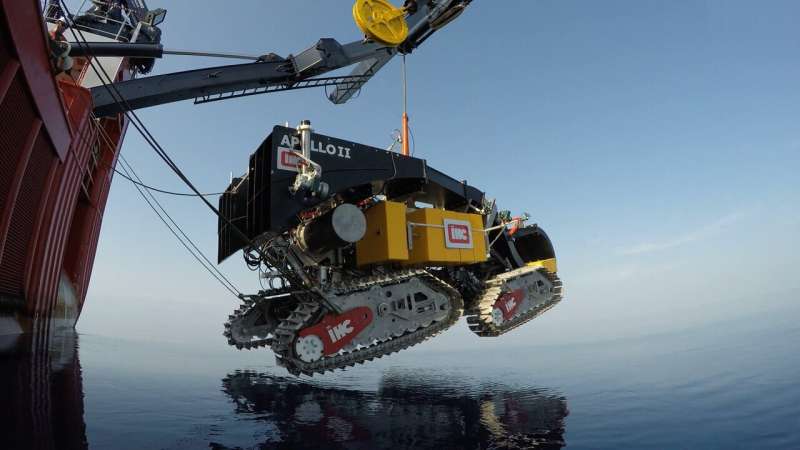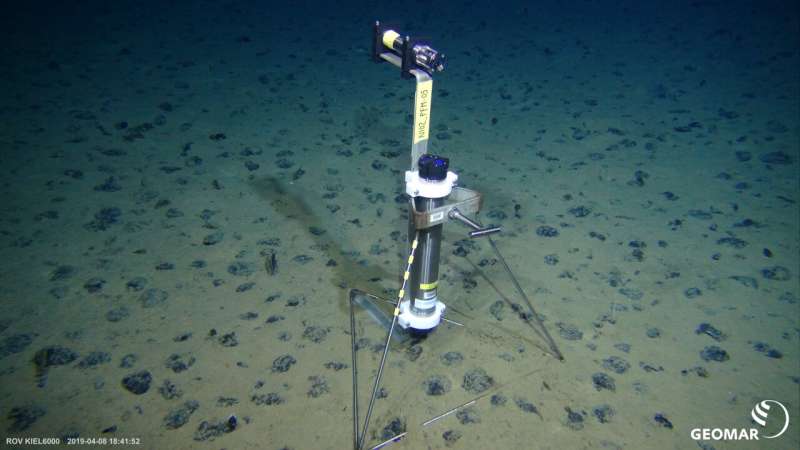New Caledonians Demand Complete Independence from France
The latest violent anti-French protests by New Caledonians seeking independence from France show clearly that it is time France respected the right of self-determination of the Kanak people of New Caledonia.
Africa Awakens provides in-depth knowledge, research and experience from an African perspective. If you are seeking more than a casual understanding of Africa, the target audience is those of African descent worldwide, foreign diplomats and policy-makers interested in Africa and last anyone interested in a detailed understanding of Africa. Read other articles by Africa Awakens.
Charlotte MANNEVY
Sun, May 19, 2024
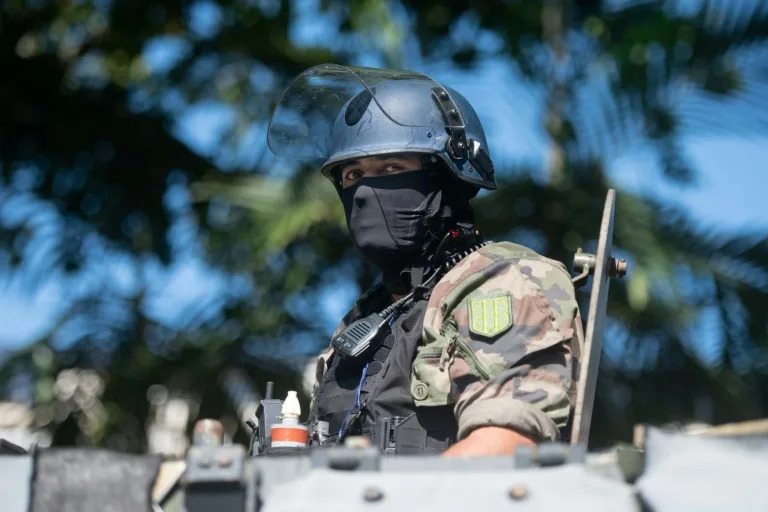
Around 1,000 police and military reinforcements have been sent to New Caledonia (Delphine Mayeur)
French President Emmanuel Macron called a meeting of his defence and security council for Monday to discuss the deadly unrest in the Pacific territory of New Caledonia.
It is the third such meeting in less than week, the previous two having resulted first in the decision to declare a state of emergency in the French territory and then to send reinforcements to help government forces on the ground restore order.
On Friday, Prime Minister Gabriel Attal met leaders of the parliamentary parties to discuss the crisis, in particular whether or not to extend the state of emergency beyond its initial 12 days.
That would require the approval of both the lower house National Assembly and the upper house Senate.
In New Caledonia on Sunday, French forces smashed through dozens of barricades in a bid to retake the main road to the archipelago's airport.
"Republican order will be re-established whatever the cost," French government high commissioner Louis Le Franc told reporters in Noumea.
If separatists "want to use their arms, they will be risking the worst", he warned.
New Caledonia, with a population of about 270,000, has been convulsed by unrest since Monday, sparked by French plans to impose new rules that would give tens of thousands of non-Indigenous residents voting rights.
The French territory off northeastern Australia has long been riven by pro-independence tensions, but this is the worst violence in decades.
Protesters have set vehicles, businesses and public buildings alight and taken control of the main road to La Tontouta International Airport, which has been forced to close to commercial flights.
- 'Short of food' -
Authorities say about 230 people have been detained while an estimated 3,200 people are either stuck in New Caledonia or unable to return to the archipelago.
France says about 1,000 additional security force members have been sent to the islands.
Some 600 heavily armed police and paramilitaries on Sunday took part in an operation to retake the 60-kilometre (40-mile) main road from the capital Noumea to the airport, authorities said.
Forces with armoured vehicles and construction equipment destroyed 76 roadblocks, Interior Minister Gerald Darmanin posted on X, formerly Twitter.
"The police came through, they cleared the road, and we stood aside. We're pacifists," said Jean-Charles, a man in his 50s wearing a scarf around his head and carrying a Kanak independence flag, a few kilometres outside the airport.
"Once they were gone, we put the roadblock back up," he added.
The highway is needed to restore supply chains as the archipelago faces shortages of items from groceries to blood for transfusions. "We are starting to run short of food," Le Franc said.
- 'This will end' -
An overnight curfew, state of emergency, ban on TikTok and reinforcements all failed to prevent more unrest from overnight Saturday to Sunday.
Groups set two fires and raided a petrol station, Le Franc's office said, as well as destroying schools, pharmacies and supermarkets.
The local government said schools would be closed until Friday. But authorities insisted the situation is improving.
Le Franc said security forces would stage "harassment" raids to reclaim other parts of the territory held by pro-independence groups.
"This will all come to an end, believe me," Le Franc added.
In Wellington, Foreign Minister Winston Peters said the New Zealand military had "completed preparations" for repatriation flights.
Australian tourist Maxwell Winchester and his wife Tiffany were barricaded in a resort on the airport road for days after they were supposed to leave Noumea.
"Every night we had to sleep with one eye open... worried that they were coming in to loot us," he said. "This morning at an exit near here, the gendarmerie was coming through and there was a shootout."
- 'Prevent civil war' -
New Caledonia has been a French territory since the mid-1800s.
Almost two centuries on, its politics remain dominated by debate about whether the islands should be part of France, autonomous or independent -- with opinions split roughly along ethnic lines.
Indigenous Kanaks make up about 39 percent of the population but tend to be poorer and have fewer years of schooling than European Caledonians. Kanak groups say the latest voting regulations would dilute the Indigenous vote.
The presidents of four other French overseas territories -- La Reunion in the Indian Ocean, Guadeloupe and Martinique in the Caribbean and French Guiana in South America -- on Sunday called for the withdrawal of the voting reform in an open letter.
Civil liberties groups have challenged the TikTok ban, with an emergency hearing scheduled at France's top administrative court in Paris for Tuesday.
burs-jj/bc
Christy Cooney - BBC News
Sun, May 19, 2024
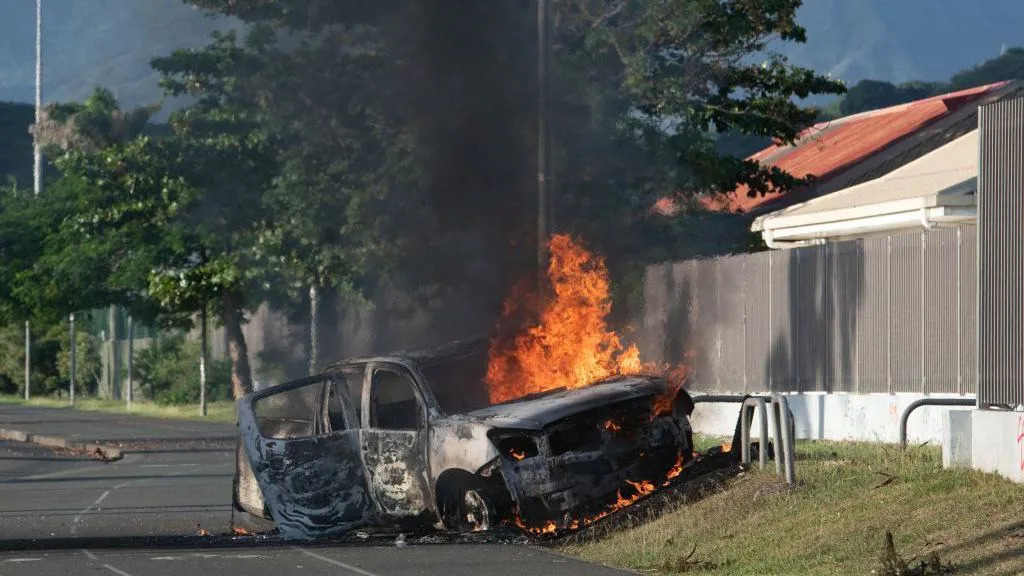
The Pacific territory of New Caledonia is "under siege", the mayor of its capital has said, following days of rioting that has left six people dead.
Nouméa mayor Sonia Lagarde said numerous public buildings on the archipelago had been set on fire and that, despite the arrival of hundreds of police reinforcements, the situation was "far from getting back to calm".
French gendarmes have launched a major operation to regain control of a 60km (37-mile) road between Nouméa and the airport, France's interior minister said.
The unrest began last week after lawmakers in Paris voted through changes that will allow more French residents to vote in local elections, a move indigenous leaders say will dilute the political influence of native people.
Officials said a sixth person was killed and two were injured during an exchange of gunfire at a makeshift roadblock in the north of the territory on Saturday.
Three indigenous Kanak residents, aged 17 to 36, and two police officers were previously confirmed to have been killed.
More than 200 people have so far been arrested and around 1,000 extra officers have been sent to join the 1,700 personnel already in the territory.
Pictures from the territory showed rows of burned-out cars, makeshift roadblocks, and long queues of people outside supermarkets.
Authorities have declared a state of emergency involving a night-time curfew as well as a ban on public gatherings, alcohol sales, and the carrying of weapons.
Speaking to French news channel BFMTV, Ms Lagarde said the last two nights had been calmer, but that the situation during the daytimes was not improving.
"Quite the contrary, despite all the calls for calm," she said.
She said it was "impossible" to quantify the damage already done but that the burned buildings included municipal buildings, libraries, and schools.
“Can we say that we are in a besieged city? Yes, I think we can say that,” she said. "It is desolation."
She added that security forces “need to be given a little time” to secure the situation.
Residents reported hearing gunfire, helicopters and "massive explosions" believed to be gas canisters exploding inside a burning building.
Helene, 42, who has been guarding makeshift barricades in shifts with neighbours told AFP: "At night we hear shooting and things going off."
With the closure of Noumea's international airport due to safety concerns, an estimated 3,200 tourists and other travellers have been stranded inside or outside the archipelago, according to the AFP news agency.
Tourists inside the territory have described having to ration supplies while they wait for a way to leave.
Joanne Elias, from Australia, who is at a resort in Noumea with her husband and four children, said she had been told to fill a bathtub in case the water ran out.
"The kids are definitely hungry because we don't really have much option of what we can feed them," she said.
"We don't know how long we're going to be here for."
On Sunday, New Zealand's Foreign Minister Winston Peters said in a statement that his country’s defence forces had "completed preparations" for flights to "bring home New Zealanders in New Caledonia while commercial services are not operating".
More French police arrive in New Caledonia amid riots
New Caledonia profile
The opposition to the changes in the law has attracted support in France, with a solidarity protest taking place in Toulouse on Saturday and Kanak flags among those being flown at a pro-Palestinian demonstration in Paris.
The unrest has also renewed diplomatic tensions between France and Azerbaijan, which grew last year following Azerbaijan's seizure of the territory of Nagorno-Karabakh.
The region, which has an Armenian majority but lies within Azerbaijan, was the subject of a long-running dispute in which France had backed Armenia.
On Friday, French government agency Viginum, which monitors foreign digital interference, said it had detected a "massive and coordinated" online campaign pushing claims that French police officers had shot pro-independence demonstrators in New Caledonia.
The government alleged the involvement of "Azerbaijani actors" in the campaign, although Azerbaijan's government has rejected the claims.
Social media app TikTok has now been blocked in the territory.
New Caledonia has held three referendums on independence. The first two showed slim majorities for remaining part of France.
The third was boycotted by pro-independence parties after the authorities refused to postpone the vote due to the Covid epidemic.
Blockades cleared after New Caledonia unrest, schools still closed
DPA
Sun, May 19, 2024
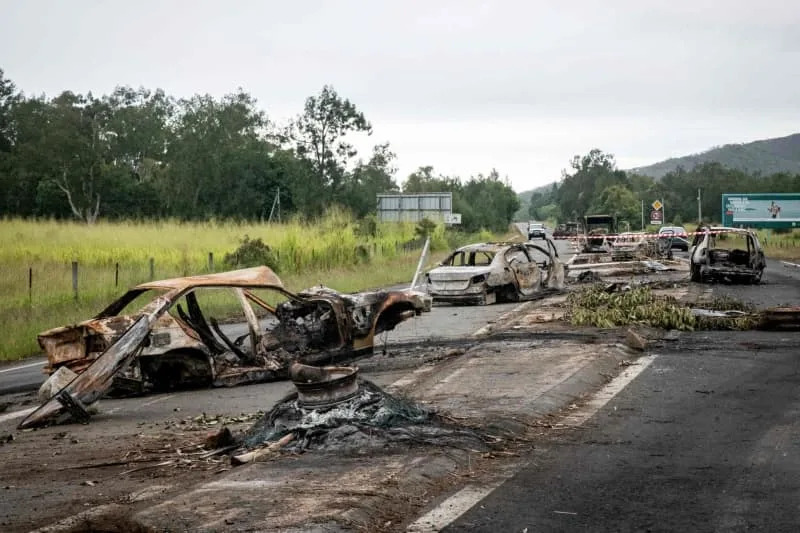
Burnt vehicles can be seen at an independantist roadblock at La Tamoa. The capital of the French Pacific territory of New Caledonia was rocked by riots after France's National Assembly approved contentious voting reforms to the territory that angered independence supporters. Delphine Mayeur/AFP/dpa
After days of serious unrest in the French overseas territory of New Caledonia, the situation appeared to be easing slightly on Sunday.
Several hundred police officers cleared the road from the capital Nouméa to the international airport of the archipelago in the South Pacific on Sunday, French Interior Minister Gérald Darmanin announced on the social media platform X.
Independence supporters had set up over 70 roadblocks in New Caledonia in the past few days, for example with burnt-out car wrecks.
Several grocery shops have also been able to reopen, according to Darmanin. However, the road is currently not passable as normal and it could be some time before the airport reopens. Schools will remain closed until next Friday, he added.
Order will be restored "whatever the cost," French High Commissioner Louis Le Franc said at a press conference. "I would like to say to the rioters: Stop, return to calm, hand in your weapons." The previous night had already been calmer, he said.
Six people have been killed so far in the riots on the island 1,500 kilometres east of Australia and over 200 people have been detained.
The background to the protests by those in favour of independence for the archipelago is a planned constitutional reform by the government in Paris, which is intended to give thousands of citizens of French descent the right to vote and therefore more political influence.
However, the Kanak population group in particular - New Caledonia's Indigenous inhabitants - have long hoped for their own state. The national council of the Kanaks accused Paris of pushing ahead with the controversial reform without taking into account the resistance of the vast majority of the Indigenous population.
The former French colony had already gained extensive autonomy through the Nouméa Agreement of 1998. Paris is currently trying to conclude a new agreement with the political forces in the geopolitically and militarily significant territory.
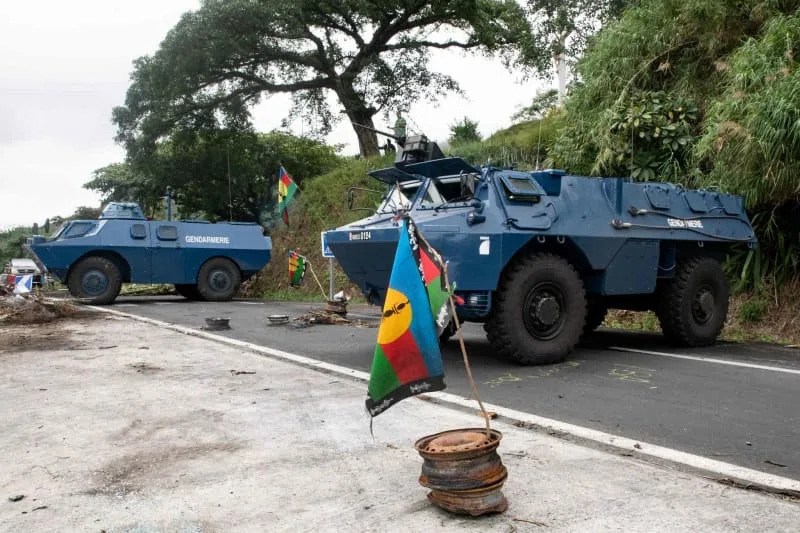
Armored vehicles of the French gendarmerie block the roadway. The capital of the French Pacific territory of New Caledonia was rocked by riots after France's National Assembly approved contentious voting reforms to the territory that angered independence supporters. Delphine Mayeur/AFP/dpa
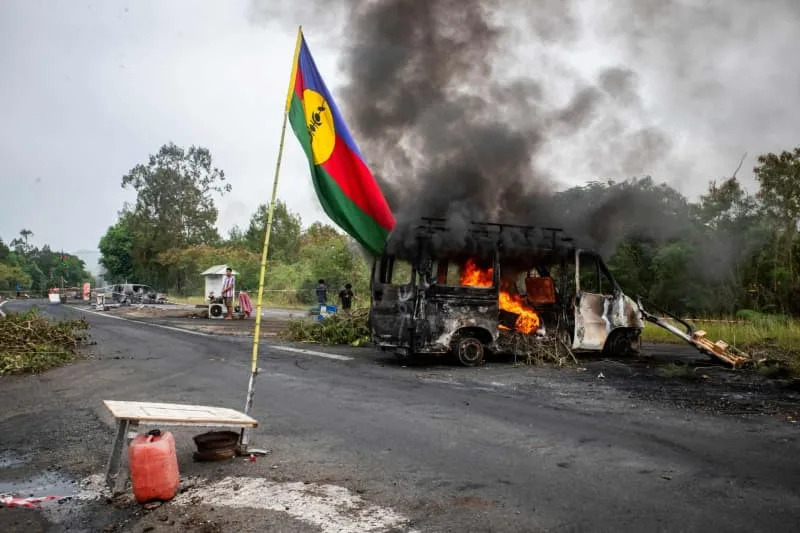
A Kanak flag waves next to a burning vehicle at an independantist roadblock at La Tamoa. The capital of the French Pacific territory of New Caledonia was rocked by riots after France's National Assembly approved contentious voting reforms to the territory that angered independence supporters. Delphine Mayeur/AFP/dpaMore
French security forces work to regain control of airport highway in violence-scorched New Caledonia
JOHN LEICESTER
Updated Sun, May 19, 2024
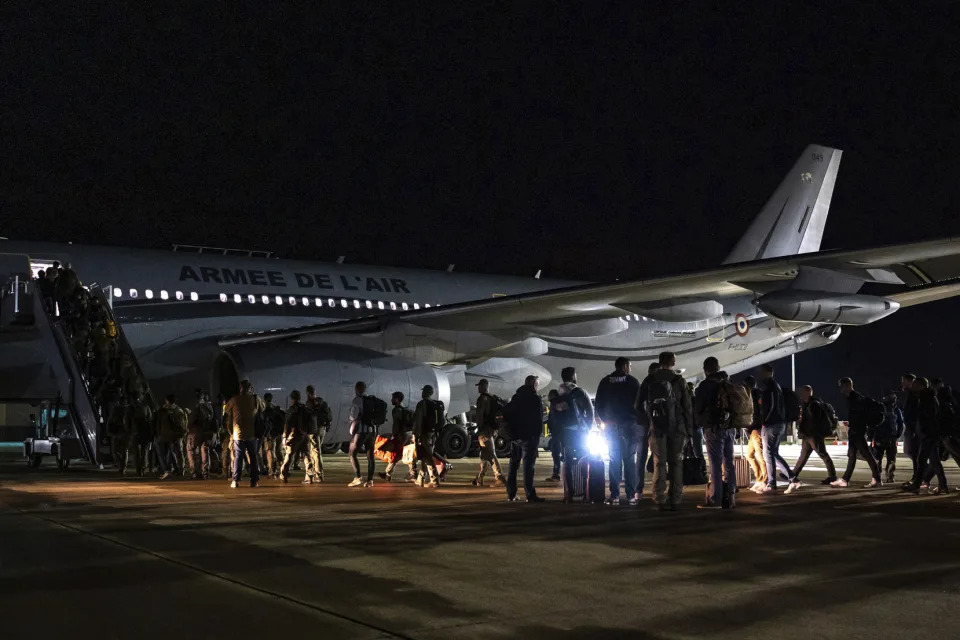
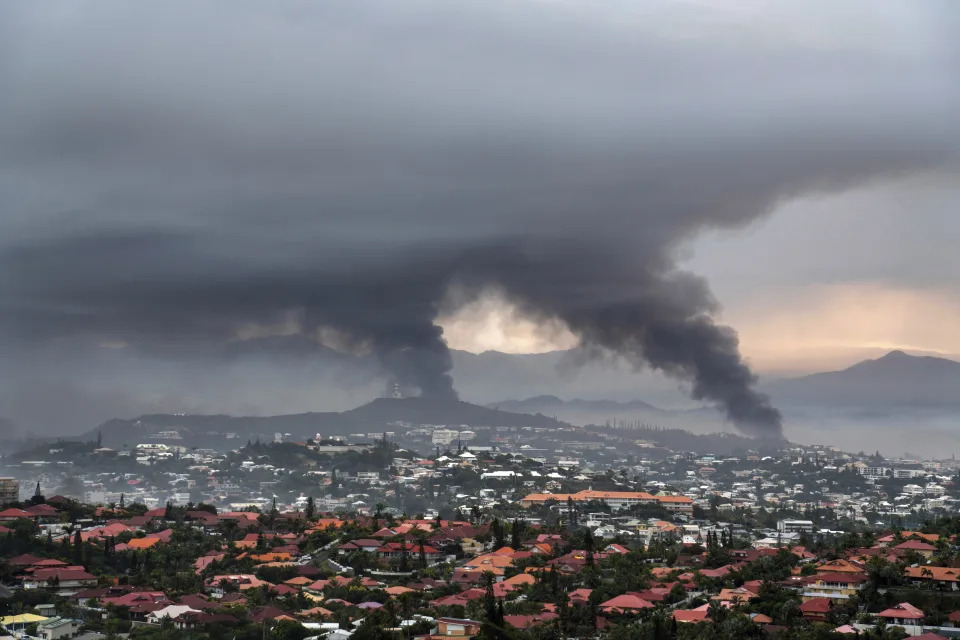
This handout photo provided by the French Army shows security force embarking a plane to New Caledonia at the Istres military base, southern France, on Thursday, May 16, 2024. Using backhoes to shove aside charred vehicles, French security forces worked Sunday, May 19, 2024, to retake control of the highway to the international airport in violence-scorched New Caledonia, shuttered because of deadly unrest wracking the French South Pacific island where indigenous people have long sought independence from France.
Using armored vehicles and backhoes to shove aside charred barricades, French security forces worked Sunday to retake control of the highway to the international airport in violence-scorched New Caledonia, shuttered because of deadly unrest wracking the French Pacific archipelago where indigenous people have long sought independence from France.
An eventual reopening of the Nouméa-La Tontouta airport to commercial flights could allow stranded tourists to escape the island where armed clashes, arson, looting and other mayhem have prompted France to impose a state of emergency. The airport, with routes to Australia, Singapore, New Zealand and other destinations, closed Tuesday as protests against voting reforms opposed by pro-independence supporters degenerated into widespread violence, leaving a vast trail of destruction.
French Interior Minister Gérald Darmanin, posting on social media platform X, said the “major operation” was “aimed at fully regaining control” of the RT1 highway between the capital, Nouméa, and the airport 60 kilometers (nearly 40 miles) to the northwest. He said more than 600 gendarmes were deployed. The number spoke to the difficulty of clearing roads of charred debris and barricades erected by pro-independence demonstrators and residents who have banded together to try to protect homes and livelihoods against rioters and looters.
The police effort to reopen the airport road cleared nearly 60 barricades on its first day, French authorities in New Caledonia' posted on X.
The French High Commission, in a statement, described the night of Saturday to Sunday as “calmer" but still spoke of two blazes and the looting of a gas station, without giving details. A 6 p.m. to 6 a.m. curfew is in effect and security forces have been granted emergency powers, including house detention for people deemed a threat to public order and expanded leeway to conduct searches, seize weapons and restrict movements, with possible jail time for violators.
The High Commission also said 230 people it described as rioters have been detained.
Nouméa’s mayor, Sonia Lagarde, told French broadcaster BFMTV on Sunday that fully clearing the airport road could take “days and days” because of "an enormous amount of burned carcasses of cars.”
“The situation is still dramatic,” she said.
Gen. Nicolas Matthéos, head of the archipelago’s public order force of gendarmes, said some barricades had been booby-trapped with gas canisters and reinforced with “walls of vehicles."
The foreign ministers of Australia and New Zealand said they are seeking French green lights to fly out their nationals.
“French authorities advise the situation on the ground is preventing flights. We continue to pursue approvals,” the Australian minister, Penny Wong, posted on X.
On Saturday, French authorities reported a sixth fatality in the violence, following an exchange of gunfire at a barricade in the north of the main island, at Kaala-Gomen.
There have been decades of tensions between indigenous Kanaks seeking independence and descendants of colonizers who want to remain part of France.
The unrest erupted Monday as the French legislature in Paris debated amending the French constitution to make changes to New Caledonia voter lists. The National Assembly in Paris approved a bill that will, among other changes, allow residents who have lived in New Caledonia for 10 years to cast ballots in provincial elections.
Opponents fear the measure will benefit pro-France politicians in New Caledonia and further marginalize Kanaks who once suffered from strict segregation policies and widespread discrimination.
France mobilises police to regain control of New Caledonia airport road
Reuters
Updated Sun, May 19, 2024
PARIS (Reuters) -French police trying to restore order in the island territory of New Caledonia after days of deadly unrest have cleared dozens of barricades that had been blocking the main road linking the airport to the capital, Noumea, a senior official said on Sunday.
Around 60 barricades that protesters had put up along the 60 km (37-mile) road have been dismantled but the road is not yet open as debris needs to be cleared, which will take several days, the territory's high commissioner, Louis Le Franc, told reporters.
The Tontouta airport is closed because of the unrest on the French-ruled South Pacific territory.
Protests erupted last week, sparked by anger among indigenous Kanak people over a constitutional amendment that will change who is allowed to participate in elections, which local leaders fear will dilute the Kanak vote.
Six people have been killed and the unrest has left a trail of burnt businesses, torched cars, looted shops, and road barricades, cutting off access to medicine and food.
Three of those killed were indigenous Kanak and two were police officers. A sixth person was killed and two seriously injured on Saturday during a gun battle between two groups at a roadblock in Kaala-Gomen, French police said, without identifying the groups.
More than 600 police were mobilised to clear the barricades on the airport road, including some 100 gendarmes who are part of a special, heavily armed unit, Interior Minister Gerald Darmanin said on X late on Saturday.
"With the forces that I have at my disposition we will be able to re-establish Republican order," said Le Franc, the high commissioner.
He said in a statement that the situation was calmer on Saturday night compared to previous nights, but added that there had been two fires and looting, and that 230 rioters had been arrested.
Dominique Fochi, secretary-general of the leading independence movement in the territory, urged calm but said the government must suspend the constitutional change.
"We need strong actions to calm the situation, the government needs to stop putting oil on the fire," he told Reuters.
The measure was approved by lawmakers in Paris and would allow French people who have lived in New Caledonia for at least 10 years to vote in provincial elections.
President Emanuel Macron has said he will delay signing it into law but that a new agreement between representatives of the territory's population must be reached before the end of June.
(Reporting by Layli ForoudiEditing by Bernadette Baum and Frances Kerry)
Updated Mon, May 20, 2024
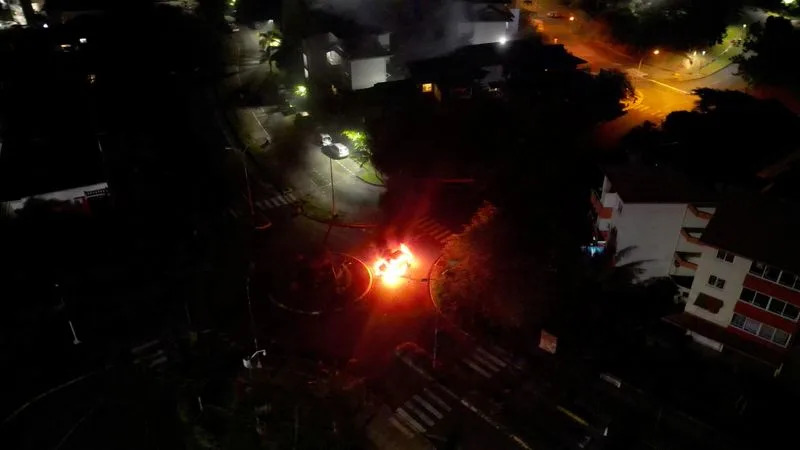
By Kirsty Needham and Lucy Craymer
SYDNEY/WELLINGTON (Reuters) -Australia and New Zealand said they will send government planes to New Caledonia on Tuesday to evacuate nationals from the French territory which has experienced a week of deadly riots, sparked by electoral changes by the French government in Paris.
France's High Commission in New Caledonia said on Tuesday the airport remains closed for commercial flights, and it will deploy the military to protect public buildings.
There were around 3,200 people waiting to leave or enter New Caledonia as commercial flights were cancelled due to the unrest that broke out last week, the local government has said.
Over 1,000 gendarmes and police from France were at work, and another 600 personnel would be added in coming hours, France's High Commission said.
Roads in Noumea are being cleared, with bulldozers removing burnt out car carcasses and debris, it added.
Six people have been killed and the unrest has left a trail of burnt businesses and cars and looted shops, with road barricades restricting access to medicine and food. The business chamber said 150 companies had been looted and burnt.
New Zealand, French and Australian foreign ministers held a call on Monday evening, after New Zealand and Australia said they were waiting for clearance from French authorities to send defence aircraft to evacuate tourists.
A meeting of France's defence council later agreed for arrangements to allow tourists to return home.
"New Zealanders in New Caledonia have faced a challenging few days - and bringing them home has been an urgent priority for the government," New Zealand foreign minister Winston Peters said.
"We want to acknowledge the support of relevant authorities, both in Paris and Nouméa, in facilitating this flight," he added. Further flights will be sent in coming days, he added.
Australia's Foreign Minister Penny Wong said in a social media post on Tuesday that clearance had been received for two "Australian government assisted-departure flights today for Australian and other tourists to depart New Caledonia".
Protests erupted last week, sparked by anger among indigenous Kanak people over a constitutional amendment approved in France that would change who is allowed to participate in elections, which local leaders fear will dilute the Kanak vote.
Viro Xulue, part of a community group providing social assistance to other Kanaks amid the crisis, said it felt like a return to the civil war of the 1980s, and people were scared.
"We are really scared about the police, the French soldiers, and we are scared about the anti-Kanak militia terrorist group," Xulue told Reuters in a video interview.
Three of six people killed in the unrest were young Kanaks shot by armed civilians, and there have been confrontations between Kanak protesters and armed self-defence groups or civilian militias formed to protect themselves, France's High Commission previously said.
"The French Government doesn't know how to control people here. They send more than 2,000 military to control, but it's fail," Xulue said.
Pro-independence political parties say they want the French government to withdraw the electoral reform before they restart talks, while France said re-establishing order was a precondition to dialogue.
(Reporting by Kirsty Needham and Lucy Craymer; Editing by Michael Perry)
Australia and New Zealand sending planes to evacuate nationals from New Caledonia's unrest
Associated Press
Updated Mon, May 20, 2024
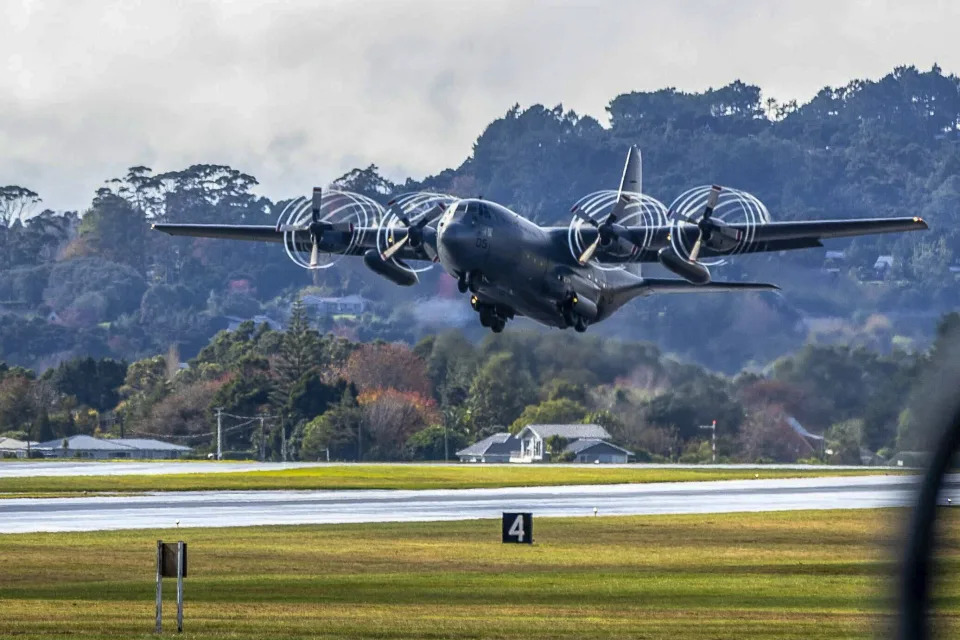
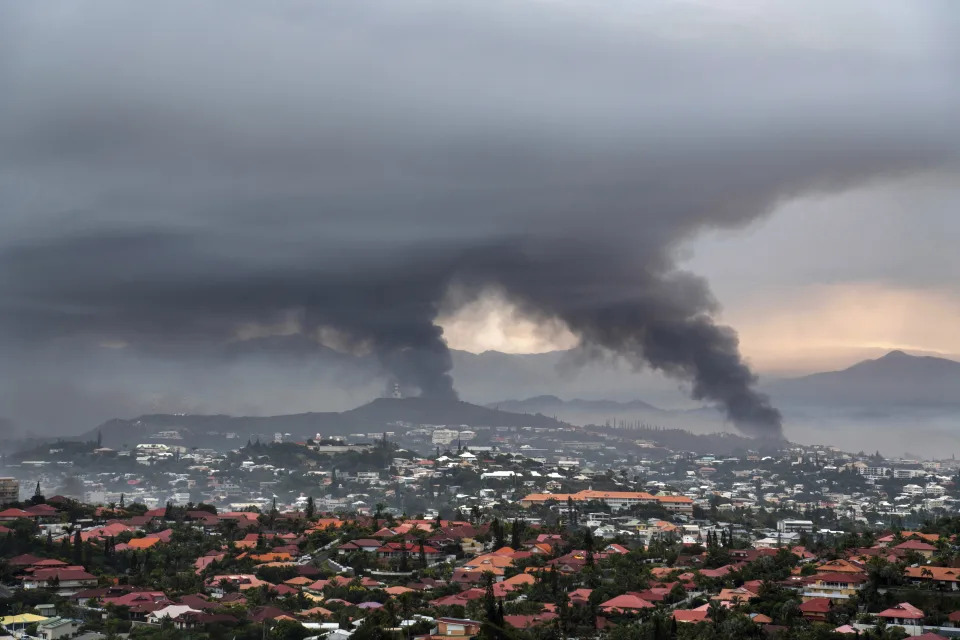
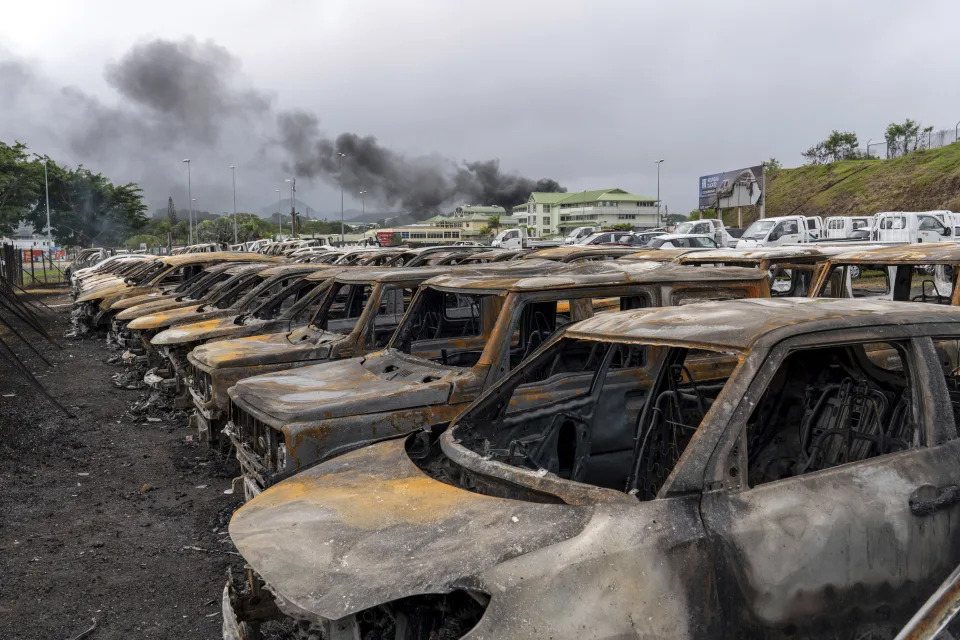


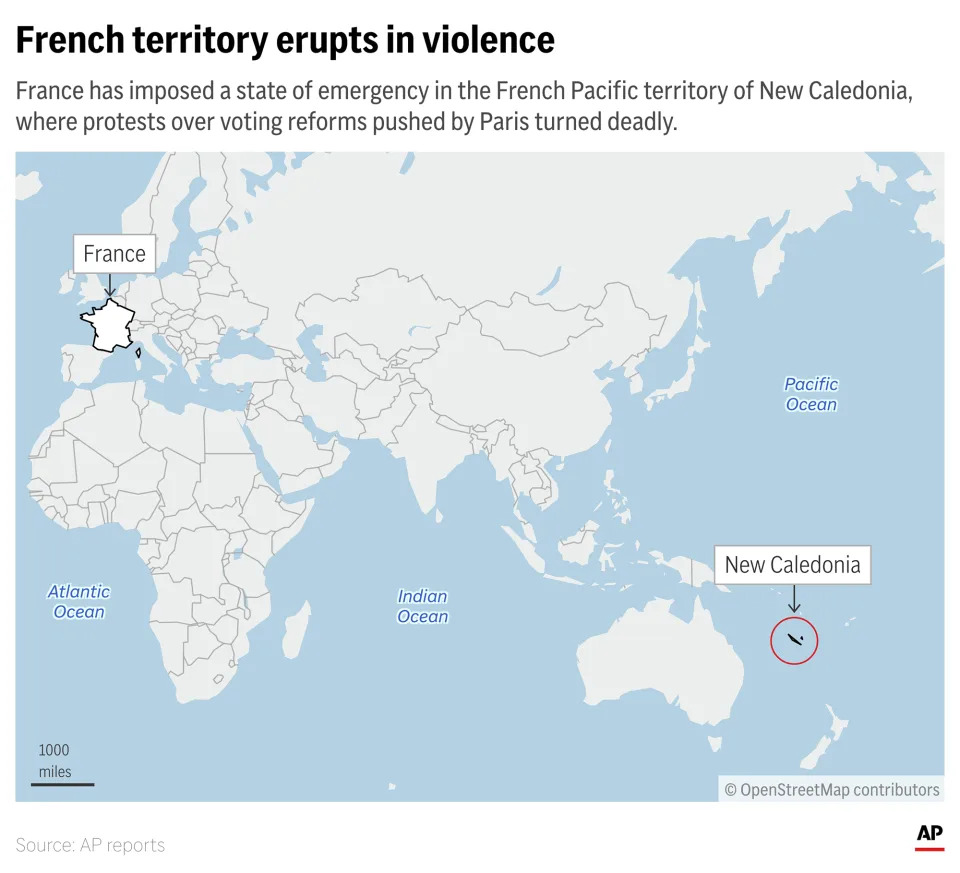
SYDNEY (AP) — The Australian and New Zealand governments announced Tuesday they were sending planes to evacuate their nationals from violence-wracked New Caledonia.
Australian Foreign Minister Penny Wong confirmed Australia had received clearance from French authorities for two flights to evacuate citizens and other tourists from New Caledonia amid violent unrest that has beset the French Pacific archipelago where indigenous people have long sought independence from France.
“We continue to work on further flights,” Wong wrote on the social media platform X on Tuesday.
The Department of Foreign Affairs said 300 Australians were in New Caledonia.
New Zealand also announced it was sending a plane Tuesday to evacuate 50 of its nationals from Noumea, the Pacific island's capital, in the first in a series of proposed flights to bring its citizens home.
“New Zealanders in New Caledonia have faced a challenging few days — and bringing them home has been an urgent priority for the government,” Foreign Affairs Minister Winston Peters said.
“In co-operation with France and Australia, we are working on subsequent flights in coming days.”
At least six people have died and hundreds more have been injured in New Caledonia since violence erupted last week following controversial electoral reforms passed in Paris.
Some 270 rioters had been arrested as of Tuesday, and a 6 p.m.-6 a.m. curfew was in effect for the archipelago of about 270,000 people.
France has sent in over a thousand security personnel, with hundreds more due to arrive Tuesday, as it tries to quell the unrest and restore control.
Armed clashes, looting, arson and other mayhem turned parts of the capital, Noumea, into no-go zones. With columns of smoke billowing into the sky, hulks of burned cars littered roads, businesses and shops were ransacked and buildings became smoking ruins.
There have been decades of tensions between indigenous Kanaks seeking independence and descendants of colonizers who want to remain part of France.
The unrest erupted May 13 as the French legislature in Paris debated amending the French constitution to make changes to New Caledonia voter lists. The National Assembly in Paris approved a bill that would, among other changes, allow residents who have lived in New Caledonia for 10 years to cast ballots in provincial elections.
Opponents fear the measure will benefit pro-France politicians in New Caledonia and further marginalize Kanaks who once suffered from strict segregation policies and widespread discrimination.
How is Azerbaijan involved with France and New Caledonia?
Daniel Harper
Sun, May 19, 2024
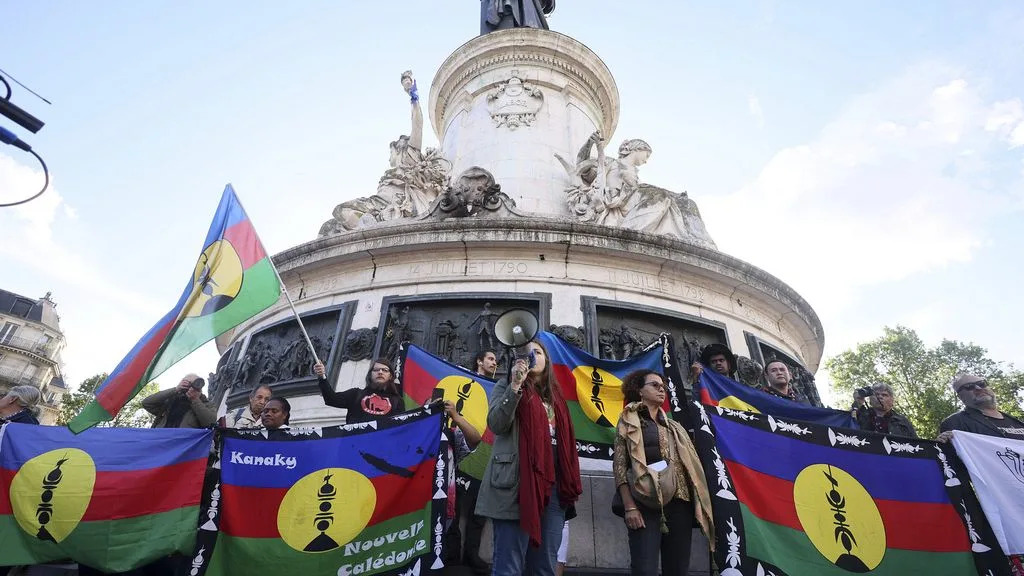
How is Azerbaijan involved with France and New Caledonia?
France has accused Azerbaijan of meddling in its Pacific archipelago territory of New Caledonia.
Despite the vast geographical and cultural distance between the Caspian state and the French Pacific territory, this claim is rooted in a complex web of historical, political, and diplomatic tensions.
The Crisis in New Caledonia
New Caledonia, located between Australia and Fiji, is a French territory with a history of striving for independence.
The recent unrest in New Caledonia was ignited by a new electoral law perceived by the indigenous Kanak population as discriminatory.
This law allows people who have lived in New Caledonia for at least ten years the right to vote in local elections, which pro-independence supporters argue will dilute the Kanak vote.
France's Accusations
France's Interior Minister, Gérald Darmanin, has publicly stated that Azerbaijan, along with China and Russia, is interfering in New Caledonia's internal matters. "This isn’t a fantasy. It’s a reality," Darmanin told the France 2 TV channel, emphasizing the seriousness of the allegations.
The French government points to the sudden appearance of Azerbaijani flags at Kanak independence protests and the backing of separatists by groups linked to Baku.
Azerbaijan has vehemently denied any involvement, calling the accusations baseless. "We completely reject the baseless accusations," said Ayhan Hajizadeh, a spokesperson for Azerbaijan's Foreign Ministry. "We refute any connection between the leaders of the struggle for freedom in Caledonia and Azerbaijan."
A significant element in this story is the Baku Initiative Group, established during a conference in July 2023 in Azerbaijan. This group, which includes participants from various French territories seeking independence, aims to support anti-colonial movements against France.
The group has expressed solidarity with the Kanak people and condemned the recent electoral reforms in New Caledonia. "We stand in solidarity with our Kanak friends and support their fair struggle," the Baku Initiative Group stated.
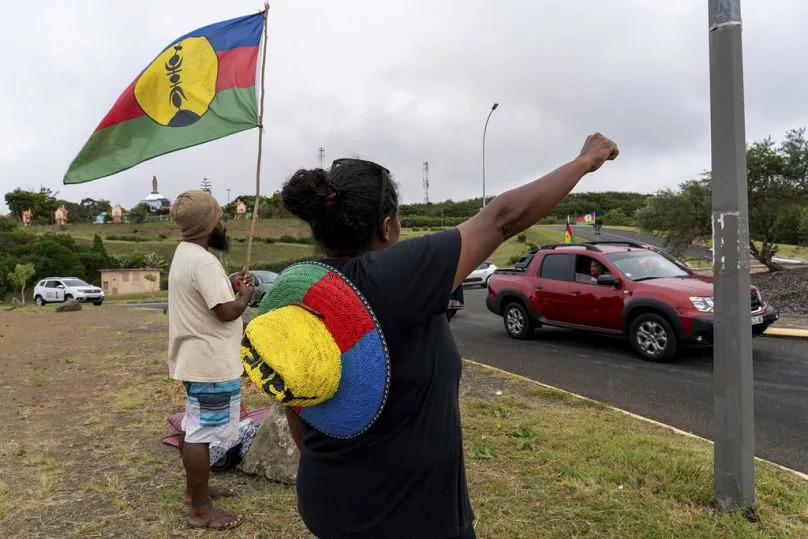
A woman waves a Kanak and Socialist National Liberation Front (FLNKS) flag in Noumea, New Caledonia - Nicolas Job/Copyright 2024 The AP. All rights reserved
Why are France and Azerbaijan clashing diplomatically?
The tensions between France and Azerbaijan extend beyond New Caledonia. France is a traditional ally of Armenia, Azerbaijan's historical rival, particularly regarding the contentious Nagorno-Karabakh region.
Following the 2020 war and a subsequent 2023 offensive by Azerbaijan to reclaim control of Nagorno-Karabakh, France has openly supported Armenia.
This support includes defence agreements and military equipment supplies, fuelling further animosity from Azerbaijan. Darmanin referred to Azerbaijan as a "dictatorship," highlighting the deep-seated distrust.
France has also accused Azerbaijan of engaging in disinformation campaigns to destabilise its territories. Pro-Azerbaijani social media accounts have been linked to the spread of misleading content about the French police's actions in New Caledonia.
A French government source mentioned a "pretty massive campaign, with around 4,000 posts generated by (these) accounts," aimed at inciting violence and mistrust.
This follows France recalling its ambassador to Azerbaijan in April, with President Macron expressing regret for Azerbaijan’s actions, along with his hope that the Azerbaijanis would clarify their intentions.
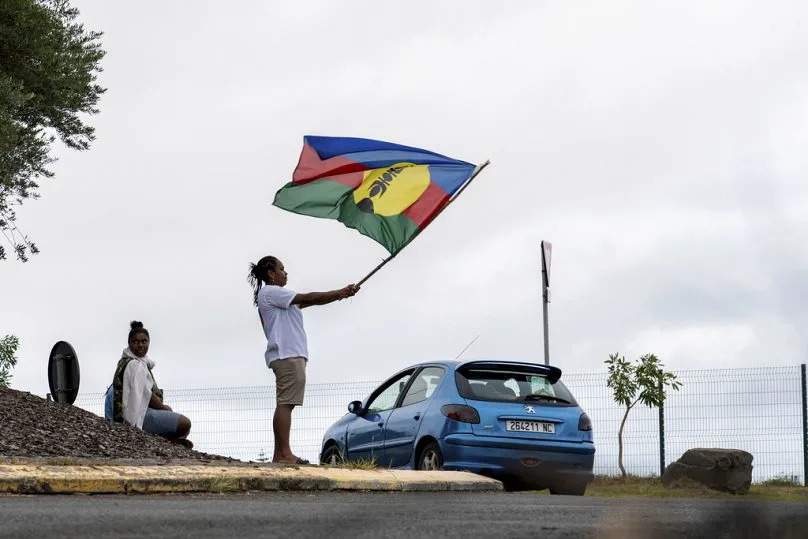
A woman waves a Kanak and Socialist National Liberation Front (FLNKS) flag in Noumea, New Caledonia - Nicolas Job/Copyright 2024 The AP. All rights reserved
Why New Caledonia?
While Azerbaijan's direct interest in New Caledonia might seem far-fetched, it fits into a broader strategy of challenging the French colonial legacy and supporting separatist movements.
By aligning with anti-colonial sentiments, Azerbaijan aims to position itself as a champion of liberation movements, simultaneously discrediting France on the international stage.
This effort is seen as part of a broader geopolitical manoeuvering, including Azerbaijan's efforts to tarnish France's image, as noted by its alleged disinformation campaign against France's capability to host the Olympic Games.
The heightened tensions have had further repercussions. The French Sports Minister cancelled the Olympic flame's journey through New Caledonia, for security reasons, but also an action that reflects the severity of the unrest and the accusations of foreign interference.
The involvement of Azerbaijan in New Caledonia's unrest is a multifaceted issue rooted in broader geopolitical rivalries and historical grievances.
For Azerbaijan, supporting independence movements in French territories is a way to strike back at France for its support of Armenia and to bolster its own international standing.
For France, these actions represent a direct challenge to its sovereignty and stability in its overseas territories, prompting strong accusations and heightened tensions between Paris and Baku.
French forces smash roadblocks in bid to clear key New Caledonia road
AFP
Sun, May 19, 2024
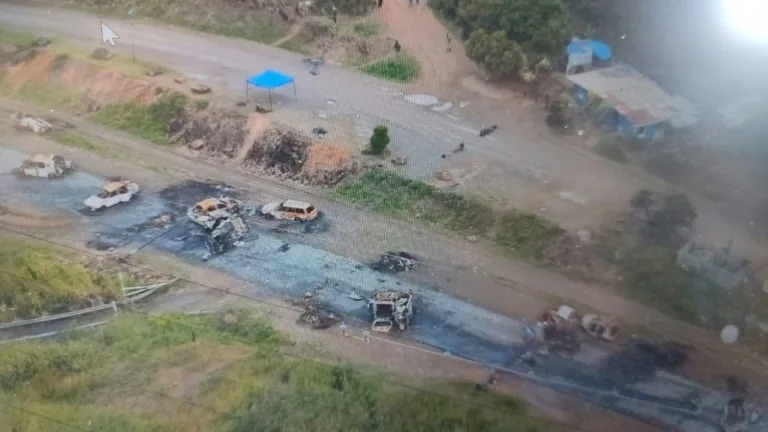
Burnt out cars scattered along the main road from New Caledonia's capital, Noumea, to the airport where French forces have launched a major operation to regain control (-)
French forces smashed through about 60 road blocks to clear the way from conflict-stricken New Caledonia's capital to the airport but have still not reopened the route, a top government official said Sunday.
And after six nights of violence that has left six dead and hundreds injured, security forces will launch "harrassment" raids to reclaim other parts of the Pacific territory, the French government representative in New Caledonia, Louis Le Franc, said in a televised address.
"Republican order will be re-established whatever the cost," Le Franc, the central government's high commissioner, warned radicals behind the violence.
The Pacific archipelago of 270,000 people has been convulsed by unrest since Monday, sparked by French plans to impose new voting rules that would give tens of thousands of non-indigenous residents voting rights.
The territory has long suffered from ethnic tensions and opposition to French rule by Kanak groups.
Authorities said 600 heavily armed police took part in an operation Sunday to retake the 60-kilometre (40-mile) main road from Noumea to the airport that has been closed to commercial flights since the unrest erupted.
The local government estimates around 3,200 people are either stuck in New Caledonia or unable to return there from abroad since flights have been cancelled.
Australia and New Zealand have been pressing France for clearance to launch evacuation flights for their citizens.
Le Franc said about 60 roadblocks put up by pro-independence groups had been "broken through" without violence.
But the official added that the route was full of wrecks of cars, burned wood and metal which had only been cleared at 15 of the roadblocks. Le Franc said the road was also damaged in several places.
AFP journalists on the road found some roadblocks had been re-established by separatists, although they were eventually able to reach the airport.
Le Franc said police units would launch "harrassment operations" in coming hours to retake "hardcore" areas in Noumea and the towns of Dumbea and Paita.
"It is going to intensify in coming days" in zones held by independence activists, said Le Franc. "If they want to use their arms, they will be risking the worst."
"I want to tell the rioters: stop, return to calm, give up your arms," added Le Franc, saying the crisis remained "unprecedented" and "grave".
mdh/tgb/tw

